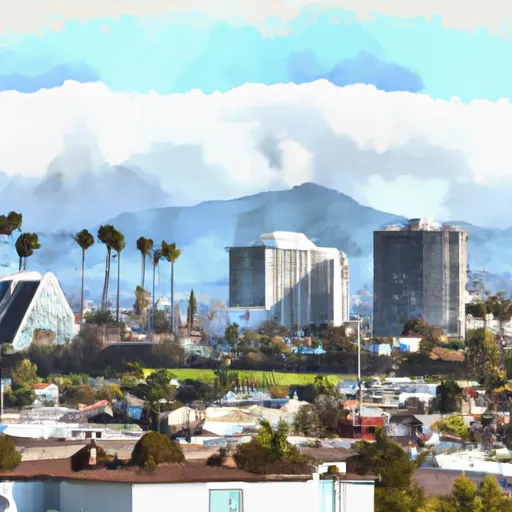-
 Snoflo Premium
Snoflo Premium
Get unlimited access to all our content
With no Ad interruptions! - Start Your Free Trial Login with existing account
San-Buenaventura
Eden Index
Climate
7.7
•
Recreation
6.5
•
Community
3.2
•
Safeguard
6.1/10

San Buenaventura, commonly known as Ventura, is a coastal city in California, located northwest of Los Angeles. The city enjoys a Mediterranean climate, characterized by mild, wet winters and warm, dry summers. Average temperatures range from 50°F to 75°F, making it pleasant year-round for outdoor activities.
Ventura is blessed with a diverse hydrology. The city is situated along the Pacific Ocean, providing stunning beaches and coastal landscapes. The Ventura River flows through the city, offering opportunities for fishing, kayaking, and riverfront walks. The river also supports a variety of wildlife, including steelhead trout.
Outdoor recreation in Ventura is abundant. Surfers flock to Surfer's Point, renowned for its consistent waves. Hikers and bikers can explore the Ventura Botanical Gardens or venture into the scenic Los Padres National Forest nearby. The Channel Islands National Park, just off the coast of Ventura, is a haven for nature lovers, offering diverse marine life, hiking trails, and camping facilities.
With its favorable climate, diverse hydrology, and numerous outdoor recreation opportunities, San Buenaventura presents an ideal destination for nature enthusiasts and adventure seekers alike.
What is the Eden Index?
The Snoflo Eden Index serves as a comprehensive rating system for regions, evaluating their desirability through a holistic assessment of climate health, outdoor recreation opportunities, and natural disaster risk, acknowledging the profound impact of these factors on livability and well-being.
Climate Health Indicator (CHI): 7.7
San-Buenaventura receives approximately
466mm of rain per year,
with humidity levels near 87%
and air temperatures averaging around
16°C.
San-Buenaventura has a plant hardyness factor of
10, meaning
plants and agriculture in this region tend to thrive here all year round.
By considering the ideal temperature range, reliable water supplies, clean air, and stable seasonal rain or snowpacks, the Climate Health Indicator (CHI) underscores the significance of a healthy climate as the foundation for quality living.
A healthy climate is paramount for ensuring a high quality of life and livability in a region, fostering both physical well-being and environmental harmony. This can be characterized by ideal temperatures, reliable access to water supplies, clean air, and consistent seasonal rain or snowpacks.
Weather Forecast
Streamflow Conditions
Ventura-San Gabriel Coastal
Area Rivers
Ventura-San Gabriel Coastal
Snowpack Depths
Ventura-San Gabriel Coastal
Reservoir Storage Capacity
Ventura-San Gabriel Coastal
Groundwater Levels
Recreational Opportunity Index (ROI): 6.5
The Recreational Opportunity Index (ROI) recognizes the value of outdoor recreational options, such as parks, hiking trails, camping sites, and fishing spots, while acknowledging that climate plays a pivotal role in ensuring the comfort and consistency of these experiences.
Access to outdoor recreational opportunities, encompassing activities such as parks, hiking, camping, and fishing, is crucial for overall well-being, and the climate plays a pivotal role in enabling and enhancing these experiences, ensuring that individuals can engage in nature-based activities comfortably and consistently.
Camping Areas
| Campground | Campsites | Reservations | Toilets | Showers | Elevation |
|---|---|---|---|---|---|
| Lake Casitas | 400 | 597 ft | |||
| Foster Park | 30 | 266 ft | |||
| McGrath State Beach | 173 | 7 ft | |||
| Dennison Park | None | 1,270 ft | |||
| Channel Islands Coast Guard Military | None | 7 ft | |||
| Fairways RV Military - Port Hueneme NCB | None | 14 ft | |||
| Point Mugu Military | None | 9 ft | |||
| Rose Valley | 9 | 3,418 ft | |||
| Camp Comfort | 15 | 578 ft | |||
| Emma Wood State Beach | 90 | -6 ft |
Nearby Fishing
Catastrophe Safeguard Index (CSI):
The Catastrophe Safeguard Index (CSI) recognizes that natural disaster risk, encompassing floods, fires, hurricanes, and tornadoes, can drastically affect safety and the overall appeal of an area.
The level of natural disaster risk in a region significantly affects safety and the overall livability, with climate change amplifying these risks by potentially increasing the frequency and intensity of events like floods, fires, hurricanes, and tornadoes, thereby posing substantial challenges to community resilience and well-being.
Community Resilience Indicator (CRI): 3.2
The Community Resilience Indicator (CRI) recognizes that education, healthcare, and socioeconomics are crucial to the well-being of a region. The CRI acknowledges the profound impact of these elements on residents' overall quality of life. By evaluating educational resources, healthcare accessibility, and economic inclusivity, the index captures the essential aspects that contribute to a thriving community, fostering resident satisfaction, equity, and social cohesion.

